Costa Rica’s All-Women Pescadora Billfish Championship 2020:
An Interview with Samantha Mumford
By Justin DeBoom
There is no better way to test an angler’s endurance than spending two days in open waters reeling in some of the toughest billfish in the world. There is no greater satisfaction than to compete against other anglers to demonstrate you are the best among them. And it doesn’t get better than catching sailfish and marlin under the Costa Rican sun.
This is what you can get at the Pescadora Billfish Championship. This all-ladies fishing tournament takes place during February in Quepos, Costa Rica.
There may be female championships for other sports, but “there is no other tournament in the world like it,” Samantha Mumford, the organizer, says. “It’s a classy high-end event for women.”
Samantha is the founder and organizer of the Pescadora. An angler herself with more than 20 years of experience, Samantha is also a business owner. Working and living in Quepos, known as the ‘fishing capital’ of Costa Rica, she has first-hand knowledge of these waters as well.
Her expertise and efforts have yielded good results—On February 20th the second Pescadora Championship will start and she took the time to give us an interview on the phone to discuss the event’s origins and impact.
Participating in the Pescadora Billfish Championship
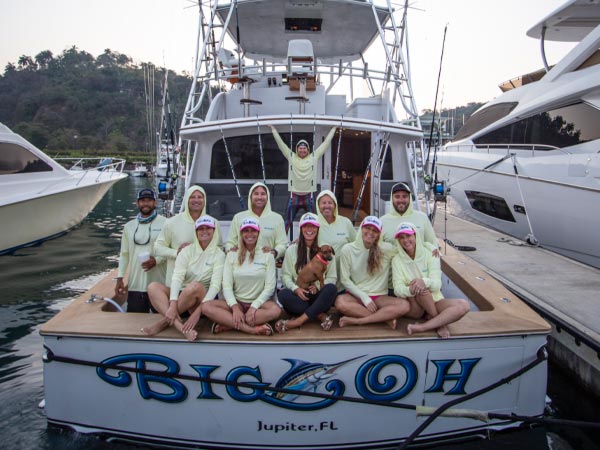
Team Big Oh during the Pescadora Championship 2019
The Pescadora is the only women anglers billfish championship of Central America, and it allows both amateur and non-amateur participants, even within the same teams. This makes it great for groups of friends who are both seasoned anglers or who are just starting and want to compete.
The idea is also to create a sense of community. This is why there is no age limit either, allowing women from the ages of 13 to 70 to compete last year.
To participate you have to register your all-women team on the Pescadora Championship website (if you don’t have a complete team, you can also register and email the details later), pay the entrance fee ($3,200 if you register before January 1st), and come to Costa Rica to fish and enjoy.
Each team must have at least two anglers, and there’s a maximum of five anglers per boat. The entrance fee includes entry badges for eight people (assuming five anglers and three crew members per group), but if you travel with a bigger group you can purchase extra badges to access the event. If you all fish, you have to register as different teams due to the event’s boat rules.
Keep in mind that you must also book fishing charters, accommodation, and transportation. If you need help with this, both the Pescadora and Fishing Vacations can help.
The Pescadora is an international event and participants can be from anywhere in the world so long as they abide by Costa Rican fisheries laws.
The Pescadora Tournament in Numbers
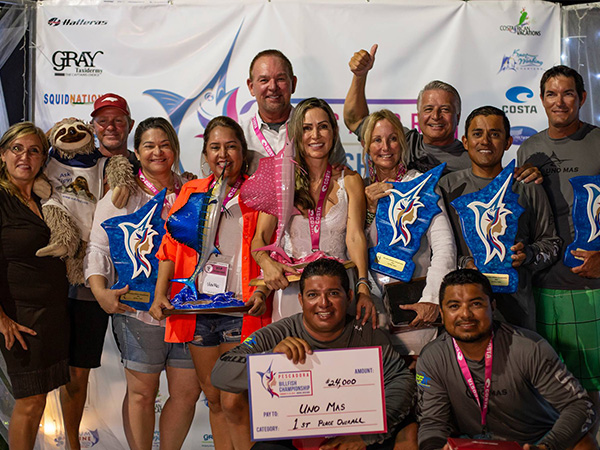
Team Uno Mas – 1st Place Winners of the 2019 Pescadora Championship
The importance of this championship is evident when you look at the numbers, too. Samantha highlights that over 38% of all anglers in the USA last year were women, which accounts for over 17 million people.
“Women are the largest emerging market within the fishing industry,” Samantha says. “But no one is paying attention to women anglers.”
That is, until now.
Last year’s results were illuminating. In 2019, there were 22 registered teams with a total of 81 female anglers from 7 different countries releasing an average of 23 billfish per day.
The final release numbers for each of the winning teams were impressive as well:
- 1st Place—Team Uno Mas—49 billfish
- 2nd Place—Big Oh—44 billfish
- 3rd Place—Game Plan—40 billfish
The biggest individual trophies went to Maria Magalhaes and Lacy Ivancevic. These women became the 2019 Pescadora Billfish Championship Female Anglers of the Year. Lacy obtained a total of 1,500 points during the event, earning her the title in the Hook & Hand Division. Maria was on top of the leaderboard with a staggering number of 25 fish, 14 of them by IGFA release, which granted her the title in the IGFA Release Division.
There was a total of $48,000 in prize money given out at the end of the event.
With a 60% increase in participation for 2020, the Pescadora will host more than 350 people and a total of 37 teams during three different events at three different locations within Marina Pez Vela, in Quepos. There will be various trophies and awards, including a prize given to the team with the best release video.
This is why there is also no age limit—allowing women from the ages of 13 to 70 to compete—and all teams get the chance to test their abilities, try their hand at different techniques, and take home two tuna and two dorado per day.
Samantha and her team also like to focus on the details. Some other perks they provide to the participants include old lavender washcloths and mimosas Samantha hand-delivers to each team in the morning.
“It’s a fun party,” she laughs.
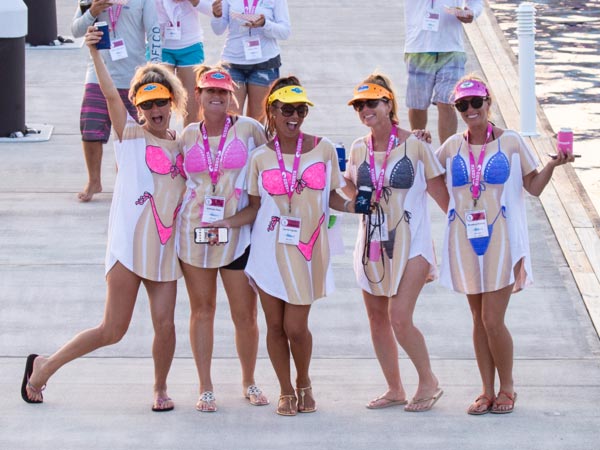
Participants Showing Coordinated Outfits at Marina Pez Vela
Immediately after we greet each other, she tells me how it all began.
The reason that it all started was that two years ago I met a gentleman called Don Dingman, and he has a show on ESPN called “Hook the Future,” and they take you fishing. And he had a young girl who was 12 years old on the boat, and she loved to fish. And she turned to him and said, “Captain Don, someday I want to be a boat captain.” And he said, “Honey, that’s wonderful news.” But she said, “But I can’t because my dad won’t let me fish in a bikini.” In her mind she thought she couldn’t be successful because she couldn’t fish in a bikini…This should not be the standard as to why popularity comes. Every ladies tournament in the United States either has a costume contest or a decorate-your-boat contest or decorate-a-bra contest, which is great, it’s fun, but there’s never been a competitive event for women. And that’s why we did it.
What has been your biggest challenge in organizing the Pescadora?
I think the biggest challenge has been making it accessible to all women.
How do you make it accessible?
We try to keep the entry fee low, so it’s split. It’s also publicity, getting it out there. Just because you fly fish, or you fish in a river or you fish in a pond… That’s actually the biggest challenge– Getting them to realize that fishing is really kind of like riding a bike. Once you have the basics, the concepts of the reel and the rod and pressure, you can apply it to any type of fishing. I think maybe coming to a foreign country or even the billfishing itself may seem intimidating, but it really isn’t. It’s the same movement, you’re basically doing the same thing, only with larger tackle. I think our biggest challenge is to make it less intimidating.
Any major changes to the event participants need to be aware of for this year?
No. We try to keep the rules minimal. It’s about the experience.
It’s about the fun.
That too. But it’s also a challenge. We’re crowning two women as female anglers of the year, we’re crowning a world championship for women.
You’re also encouraging people to tag their catch, right?
That is huge, thank you for reminding me. With Gray Fish Tag Research, last year the women tagged 187 billfish in two days, which is more than anywhere in the world at one time. Which is huge for research. And another thing—Out of 22 teams, they released 512, which is more billfish released than any ladies’ tournament in the world.
That’s from last year. Do you hope these numbers will increase?
I hope it’ll increase drastically. Let’s hope the fish gods are there.
From what I hear I gather the public has responded positively to it.
Yes, and even more so in Costa Rica! Every time we explain it, women are just like “Wow, that’s incredible!” They think it’s really neat that we’re doing this for women. We’re only on the second year and each year this grows. The idea, too, is to really try and promote Costa Rica. Eventually maybe try to get the Tourism Board involved because it’s a big deal for women if you can get that out there, that Costa Rica supports female anglers.
Why should anglers come here? Why Costa Rica, why Quepos? What makes this different?
Marina Pez Vela. It’s a wonderful marina, they’re incredibly supportive, it’s beautiful. And the reason why this area is so perfect for this tournament is because it’s consistently flat calm waters. The seas are probably 90% of the year flat calm, so it makes it very comfortable to be able to go out offshore, and the fishing in February is some of the best in the world.
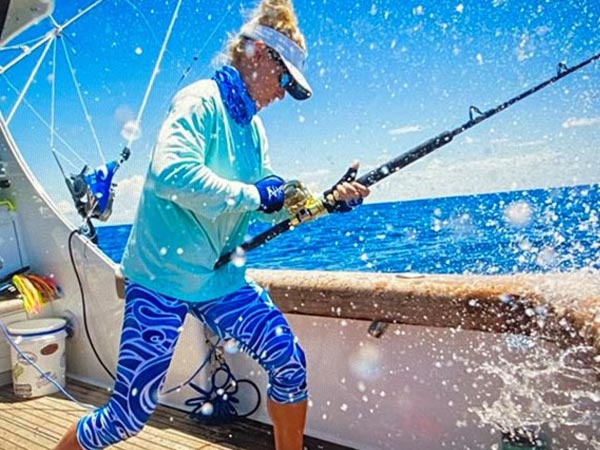
Angler Reeling in Billfish during the Pescadora Championship Last Year
You say this event is about female anglers having a space to hone their skills. How can they do that in the tournament?
We award first, second, third, and fourth place team. And then we also award the two top female anglers, one on each division, the amateur and non-amateur division. The ultimate goal obviously is to try and win as a person one of these trophies. But because billfishing is a team sport—everything from the captain, to the mate, to the anglers—it’s definitely a very intertwined team.
It’s like a group effort for individual goals, would you say?
Yeah! That sounds great.
You can use it if you want.
(laughs) I will!
What about the fishing industry and other sponsors? Have you gotten good reactions from them?
Absolutely. We have Costa Sunglasses come on this year as a presenting sponsor, which is enormous—They’re a globally known brand so for them to be associated with us as a presenting sponsor was a huge honor. And then we have multiple companies on a smaller scale. We’ve got nautical interior design from a local Costa Rican woman, to FECOP, the federation of fishery, to mechanics, to fishing clubs… It’s a really neat plethora. We have a local woman who makes bikinis, Brujas del Mar. They’re the women that when they limited the shrimp harvest, they were going to lose their jobs, so what FECOP did was they helped them start a lure-making company. And they’re going to sell their products at the Pescadora. We had a local artist hand-paint all of our trophies, we had a local wood sculptor make all of the trophies.
It’s not just other companies being interested in you, then. It’s you guys helping the local community.
Absolutely.
The tournament is also an opportunity to be social, maybe do some networking. What’s the best part of the different gatherings and parties you organize?
It’s camaraderie! It gives marketing partners the opportunity to interact face to face with their target audience. It’s getting to know each other, asking questions. Last year I remember overhearing a conversation between two different teams, two different women. One of the women was in the winning team of that day, and she was asking her a technical question about how she holds a rod. Everybody is willing to work together and they’re not trying to withhold information from each other.
Even though it’s a competition they’re willing to help each other out.
Exactly!
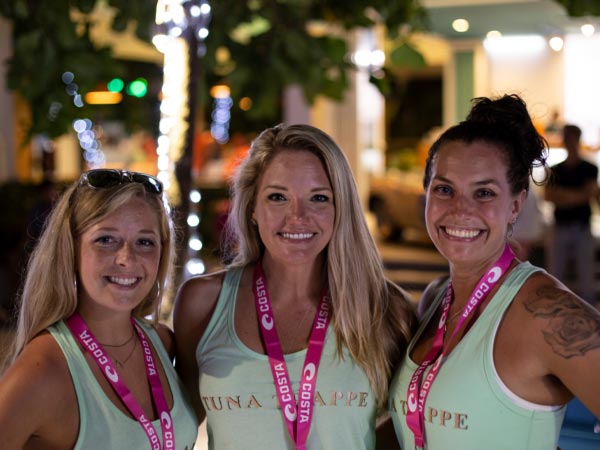
Participants at the Welcome Party for the Pescadora
What’s your favorite moment from last year?
That’s a good question. It was probably the captains’ meeting, the kick-off party. When I was up there talking, seeing the faces and the excitement… I’m in awe of these women. And my other favorite moment obviously was at the awards ceremony, seeing women tear up and how proud they were. It’s a lot of work. Imagine taking a 10-foot by 10-foot square, and putting it out in the sun with no shade and standing in that one spot for nine hours a day for two days in a row. It’s not easy. We say it’s the most fun you’ve ever had being so sweaty.
You’re going to suffer but you’re going to love it.
Exactly! You feel like you’ve accomplished something you’re proud of. We don’t make it easy.
I imagine those are also your most rewarding moments?
My other is obviously hearing my seven-year-old saying “Mom, when can I fish the Pescadora?” That’s pretty special.
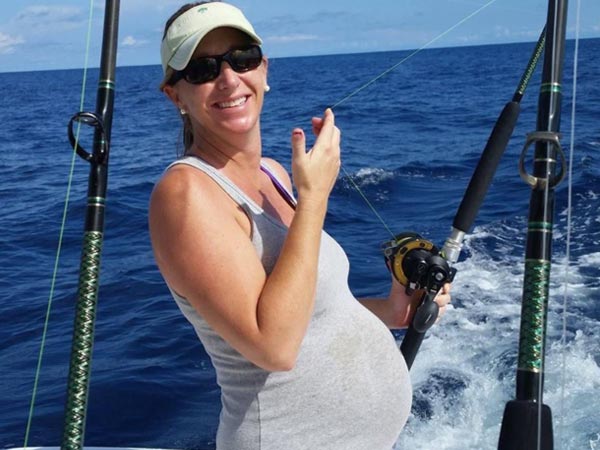
Samantha Mumford, Founder and Organizer of the Pescadora Championship
I only have one final question. In your own words, what makes a good angler?
That’s a really tough question. Patience. My husband always told me that the difference between a good angler and a great angler is how you handle your misses. You have to be able to compartmentalize it and not get yourself down. My other favorite thing is you have to miss a lot in order to learn to catch a few. You can beat yourself up, especially at the end of the day when you find out you were one or two fish away out of the lead. That’s my most difficult part—learning how to shake it off because if you let it get to you it will ruin the rest of the day. Everybody misses, you know.
The Pescadora Event 2020 starts on February 20th and ends on February 23rd, 2020. Keep up with the results on our fishing report and the Pescadora Facebook page. If you’d like to participate next year, contact us and we can make it happen!